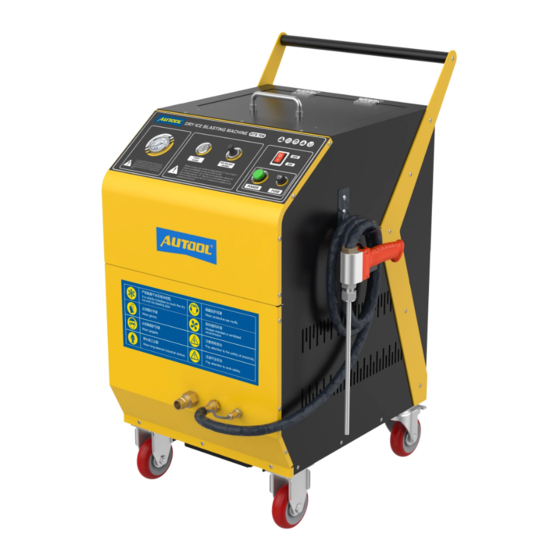Autool HTS708 Manuel - Page 3
Parcourez en ligne ou téléchargez le pdf Manuel pour {nom_de_la_catégorie} Autool HTS708. Autool HTS708 13 pages.

Precautions
1. Before using the instrument, please read this manual carefully for proper
operation.
2. It is strictly forbidden to touch the dry ice and ice blasting pipe.
3. It must be kept clean when adding dry ice, and no other foreign objects fall
into the equipment.
4. This equipment uses solid CO2 particles, and ventilation must be ensured
when operating dry ice cleaning.
5. Before carrying out the work, it is necessary to wear protective goggles, ear
muffs, work clothes and gloves.
6. Before each work, set the ice supply speed to "0" and test if condensate is
sprayed out of the nozzle.
7. Whenever the operation is not finished and you need to pause in the middle,
please first set the ice speed to "0" and then turn on the blasting gun for 30-50s
to ensure that the leftover ice is blasted out of the ice outlet tube to prevent ice
blockage.
8. In order to ensure sufficient pressure and flow of compressed air from the air
source, please choose the supply pipe of the air source larger than DN20 outside
diameter and the pressure of the air source larger than 6 bar, so as to have a
better cleaning effect.
9. To prevent electric shock, do not touch the working equipment in wet areas or
operate the equipment in the rain.
10. In the middle of ongoing work, if you encounter equipment failure, please
immediately disconnect the power.
Principle Introduction
Dry ice blast cleaning technology is based on the use of ultra-low temperature
dry ice particles, and by compressed airflow, the dry ice particles are hit by the
gas at high speed to be cleaned surface dirt. The sudden drop in temperature of
the dirt on the surface causes the surface to become brittle while causing these
extremely low-temperature dry ice gases to enter inside the cracked
contaminants. When surface dirt is hit, the dry ice particles quickly sublimation to
gas and these cracked contaminants are peeled away from the surface of the
object and removed.
